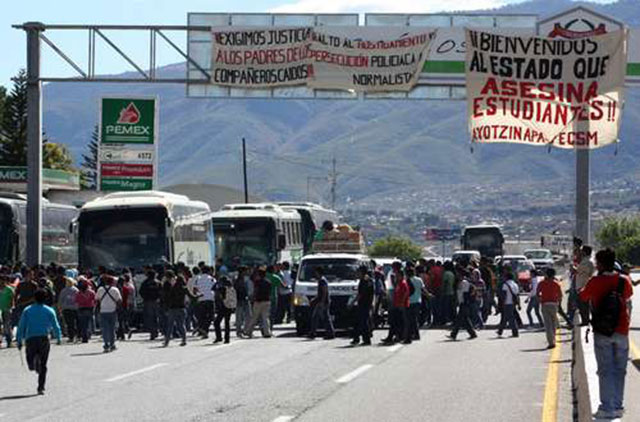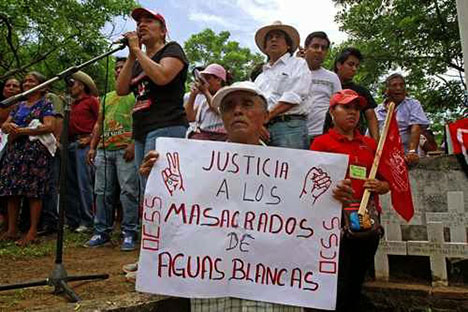
March 2015
In Guerrero, the
Dirty War
Never Ended

The dirty war never ended: students from Ayotzinapa protest the massacre of their compañeros by state and federal police in December 2011. (Photo: Lenin Ocampo/Jornada)
The fact that the crime of Iguala is no anomaly but one more link in the chain of deadly violence that characterizes bourgeois politics in this country can be confirmed by casting a brief glance at the history of the state of Guerrero over the last half century.
Already in the late 1950s, Guerrero was experiencing a reign of terror unleashed by the tyrannical governor, General Raúl Caballero Aburto, of the Institutional Revolutionary Party (PRI), who was charged with having murdered more than 30 people, and tortured many more. In order to fight him, a Guerrero Civic Association (ACG) was formed, which included members of the Mexican Communist Party and of the Popular Socialist Party. A number of the dead were thrown into the Pozo Meléndez sinkhole (also known as the Devil’s Mouth) near Taxco, which is where many of those persecuted during the Dirty War of the 1960s and ’70s ended up. It’s also very close to where the Aytozinapa students were disappeared last September 26.
Caballero Aburto was ultimately removed following the murder by army soldiers of 19 students in Chilpancingo, on 30 December 1960. Later, protests against the electoral fraud orchestrated by the PRI ended with a massacre of 31 December 1962, in Iguala. The ACG, led by the teacher Genaro Vázquez Rojas, a graduate of the Ayotzinapa Rural Teachers College and a member of the Revolutionary Movement of Teachers (MRM), organized a “civic work stoppage” in front of the municipal building. With the support of police and the army, white guards (private armies of gun thugs hired by local bosses) attacked the demonstration, leaving eight dead and 280 arrested. Following this massacre there was a “scorched earth” operation to take back the municipalities which been won by the Civic Association.
After several years as a rural school teacher, Genaro Vázquez was captured by the Guerrero police in 1966. On 18 May 1967, judicial police carried out another massacre, this time against protesting teachers in Atoyac de Álvarez, in the Costa Grande region. The judicial police fired on the crowd from the rooftops of houses, leaving a toll of between five and nine people dead and various wounded. See the vivid description of the slaughter in the magnificent book of Carlos Montemayor, Guerra en el paraíso [War in Paradise] (1991).
This set off the guerrilla uprising of Lucio Cabañas, who was leading the protest meeting in Atoyac. For his part, Genaro Vázquez, after being liberated by a guerrilla commando in 1968, undertook guerrilla struggle in the regions of Las Montaña and the Costa Chica under the name of the National Revolutionary Civic Association. He died in a traffic accident in February 1972 in obscure circumstances. According to the report/novel of the always well-informed Carlos Montemayor, Genaro was finished off by a military man.
During the 1970s and ’80s, Guerrero was the scene of one of the bloodiest episodes of the dirty war against the guerrillas. The state was literally subjected to a state of military siege. The 27th Military Zone, with headquarters in Acapulco, was outfitted with the most modern military equipment of the time. The Federal Security Directorate and the Army carried out massacres of entire peasant settlements, applying brutal counterinsurgency techniques in order to sweep away popular support for the guerrillas. As Laura Castellanos, author of México armado (2007), commented:
“Guerrero also has the infamous honor of being the first place in the Americas where so-called ‘flights of death’ were inaugurated, even before they were used by South American dictatorships; dozens, perhaps hundreds of civilians were transported in military airplanes and then dumped, alive in the high seas. Others were incinerated or thrown into mass graves.”
–“Before and After Iguala”[in Spanish] Milenio, 20 November 2014,
The final report of the Truth Commission for Guerrero, published last fall, recounts that between 1974 and 1981 around 1,500 people were tossed into the sea, some of them alive (La Jornada, 18 October 2014).
Military control of the state strengthened the caciques (local
bosses) and their paramilitary gangs. In various areas, the
army permitted large-scale planting of marijuana and poppies,
which generated a kind of “social base” for the
counterinsurgency linked to drug trafficking. Despite the
extermination policy, some groups dating back to the guerrilla
groups of Lucio Cabañas and Genaro Vázquez managed to survive
into the 1990s. In order to revive repression against peasant
communities which might give them cover, PRI governor Rubén
Figueroa Jr. undertook the massacre of 17 members of the
Peasant Organization of the Southern Sierra (OCSS) in Aguas
Blancas, on 28 June 1995. A year later the
formation of the Popular Revolutionary Army (EPR) was
announced.
 The dirty war never ended: hundreds
marched from the community of Aguas Blancas, in Coyuca de
Benítez, Guerrero, on 28 June 2014 to mark the 19th
anniversary of the massacre of 19
members of the Peasant Organization of the Southern Sierra. (Photo: Javier Verdin/La Jornada)
The dirty war never ended: hundreds
marched from the community of Aguas Blancas, in Coyuca de
Benítez, Guerrero, on 28 June 2014 to mark the 19th
anniversary of the massacre of 19
members of the Peasant Organization of the Southern Sierra. (Photo: Javier Verdin/La Jornada)Due to the uproar over the Aguas Blancas massacre, the governor was forced to request a leave and was replaced by Ángel Aguirre Rivero. But the killings didn’t stop. On 7 June 1998, in the community of El Charco, municipality of Ayutla de los Libres, soldiers of the Mexican army threw fragmentation grenades into a primary school, killing five Indians sleeping there. This was followed by the devastating effects of [Mexican president Felipe] Calderón’s war on drug trafficking from 2007 to 2013 in which more than 100,000 people were killed, 8 percent of them in Guerrero (Alejandro Poiré in Nexos, 11 February). Some 8,000 Guerrero residents lost their lives in this war ordered by the White House, the Pentagon and their puppets in Los Pinos [Mexico’s White House].
As staunch defenders of democratic rights, revolutionary Marxists oppose all laws against the production, selling or consumption of drugs, as well as laws concerning the use of alcohol or tobacco, as a violation of individual liberties. As we have underlined, the “war on drugs” is a dispute between sectors of the bourgeoisie for the purpose of maintaining a pervasive military and police presence in the impoverished areas of the countryside and in working-class neighborhoods in the cities. It also reflects the subordination of Mexican bourgeois governments to Yankee imperialism in its pernicious counterinsurgency wars in Latin America since the 1960s.
Even so, the dirty war in Guerrero never ended. The murder of two students from Ayotzinapa by state police in the Autopista del Sol superhighway on 12 December 2011 was the most notable event of the first year of Ángel Aguirre Rivero’s second term as governor of the state (this time for the Party of the Democratic Revolution [PRD]). And now he has ended by requesting a leave over the massacre of Iguala of 26 September 2014, the worst of all, but not the first … nor the last. The drums of the dirty war will continue beating out their deadly cadence, and the church bells will keep tolling their chimes of mourning, until a socialist revolution puts an end, once and for all, to this diabolical capitalist machinery of death.■
